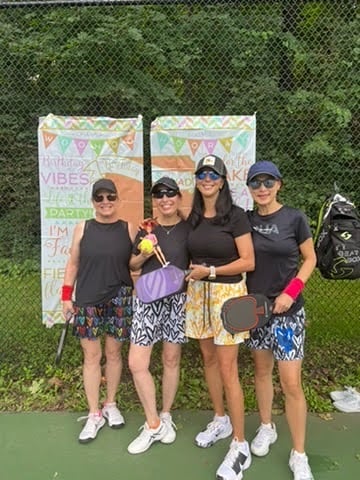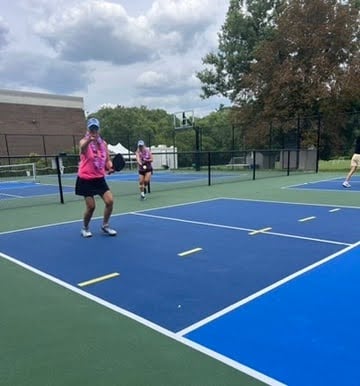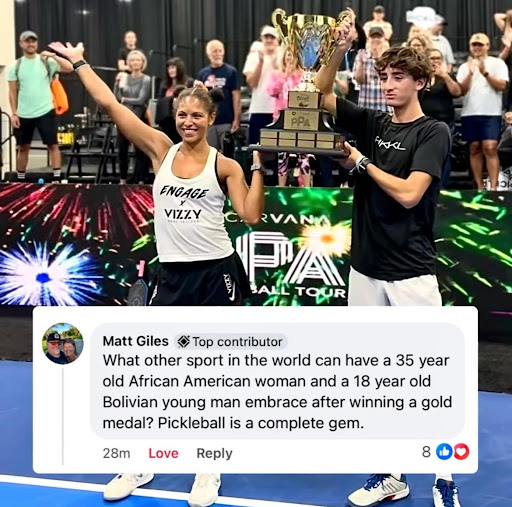Before entering the world of pickleball, I was fully immersed in soccer and downhill skiing.
Both of these sports offered strong social components: traveling across Ontario for soccer tournaments with my team, and packing the car full of friends and skis for weekend trips to the slopes.
These experiences weren’t just about the sport itself - they were about connection, camaraderie, and shared memories.
There’s something special about the social nature of each sport, but I’ve come to believe that pickleball has a uniquely powerful way of bringing people together.
Its approachable gameplay, emphasis on fun, and community-oriented culture make it stand out. Here are a few reasons why...
Inclusive and Easy to Learn
Pickleball is one of the most accessible sports around.
The rules are straightforward, and the smaller court makes it easy for people of all fitness levels, body types, and ages to participate. Compared to sports that require years of technical training, pickleball is simple to pick up.
You don’t need to have a history of athleticism or invest in expensive gear, just a paddle, a ball, and a court. This low barrier to entry allows more people to give it a try, and often, they get hooked.
What makes this inclusivity so important is how it brings together people who might not otherwise cross paths.
You’ll find retired seniors playing alongside young adults, complete beginners matched with more experienced players - all on the same court, all laughing together. That’s a rare kind of magic.
Two vs Four
Pickleball is most commonly played in doubles, which naturally encourages interaction and teamwork.
Unlike singles tennis, where the focus can feel individualistic, pickleball’s four-player format promotes constant communication, shared strategy, and a social back-and-forth that’s hard to replicate elsewhere.
Additionally, the space efficiency of pickleball is impressive. You can fit four pickleball courts into the space of one tennis court.
That’s up to 16 players on the same footprint where only four might be playing tennis. The result? More people in the same space, more interaction, and more opportunities for friendships to form.
It’s easy to see why the environment feels so alive and welcoming.

Image credit: saramcinnes002
Mix of Ages and Skills
Another strength of pickleball is its ability to accommodate a wide range of skill levels and age groups.
It’s not unusual to see a 70-year-old playing a competitive match with a 30-year-old, or a complete novice paired with a seasoned regular.
Rather than dividing people into skill brackets or leagues, many pickleball clubs encourage casual play and spontaneous doubles matches, which creates a natural blending of players.
This kind of multigenerational interaction fosters respect, patience, and mentorship. Younger players learn the value of experience and game sense, while older players stay active and engaged with a new generation of athletes. The result is a vibrant, diverse community where everyone has a place.
A Casual, Welcoming Atmosphere
The vibe on a pickleball court is noticeably relaxed. While competitive play definitely exists - especially at the higher levels - most games are driven by fun, not pressure.
Laughter, friendly banter, and light-hearted teasing are common sounds during a match. This is part of what keeps people coming back: it feels less like an obligation and more like a social outing.
Even professional circuits like the PPA (Professional Pickleball Association) and APP (Association of Pickleball Professionals) lean into this social energy.
Music often plays in the background during matches, and the overall presentation is far more inviting and laid-back than what you might see at a tennis Grand Slam.
It’s a conscious effort to maintain the culture that makes the sport so special, even as it grows.
Community Events and Shared Experiences
Pickleball is not just a sport - it’s a social hub. Across cities and towns, local pickleball communities host events, tournaments, potlucks, and even charity fundraisers.
These gatherings extend the social experience beyond the court, giving people more ways to connect.
Whether it’s a weekend round-robin or a holiday-themed doubles event, these social functions reinforce a sense of belonging.
It’s common for friendships to form that go well beyond the game. In many cases, these communities become a core part of people’s daily routines and support networks.

Image credit: saramcinnes002
Accessible and Inclusive by Design
A major reason pickleball has grown into a social phenomenon is because of how inherently accessible it is.
The smaller court reduces physical strain, and the lightweight paddles are easier to handle than traditional racquets. Players don’t need to run great distances or execute complicated techniques to be competitive.
Because of this, the sport is especially popular among older adults, people with mobility challenges, and those who are new to sports in general.
This inclusive design supports a wide range of players, ensuring that almost anyone can take part and feel successful. That, in turn, contributes to a richer, more welcoming community.
Promoting Health and Well-being
Beyond the fun, pickleball offers serious mental and physical health benefits. Like any physical activity, it boosts endorphins, helps manage stress, and supports cardiovascular health. But the social element makes these benefits even stronger.
Playing in a group setting fosters connection and helps fight feelings of isolation, especially for older adults or people going through major life changes.
Regular play creates routine, provides purpose, and helps people stay physically and emotionally engaged.
Because it’s low-impact, pickleball is also more sustainable than other sports, allowing players to continue participating regularly without the same injury risks.
That consistency is key to long-term health benefits.

Image credit: @thekitchenpickleball
The Future of Pickleball’s Social Impact
As pickleball continues its meteoric rise, its social influence will likely grow as well.
With more coverage in the media, more investment in facilities, and increasing recognition at the professional level, the sport is poised to become even more mainstream.
What’s especially promising is its integration into schools, community centers, and recreation programs.
Young people are getting introduced to pickleball earlier than ever, and that sets the stage for lifelong engagement - not just with the sport, but with the community it builds.
As pickleball expands, it has the power to remain a space where people connect, laugh, compete, and support one another - on and off the court.
This article was taken from our 'Control the Kitchen' Newsletter, if you're interested in receiving more content like this, please feel free to sign up using the subscribe section located at the bottom left of this page (or underneath the article if you're on mobile), thanks!